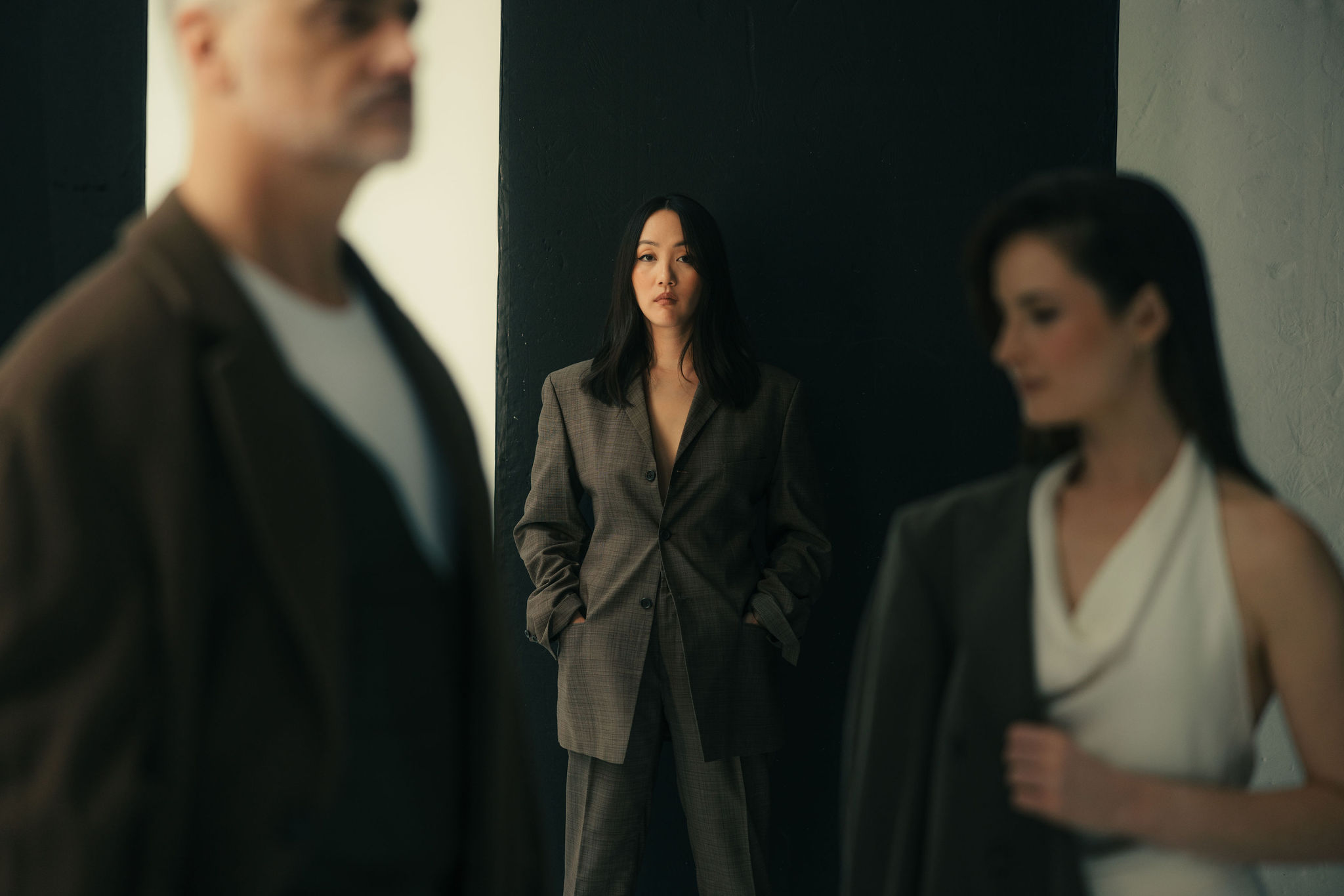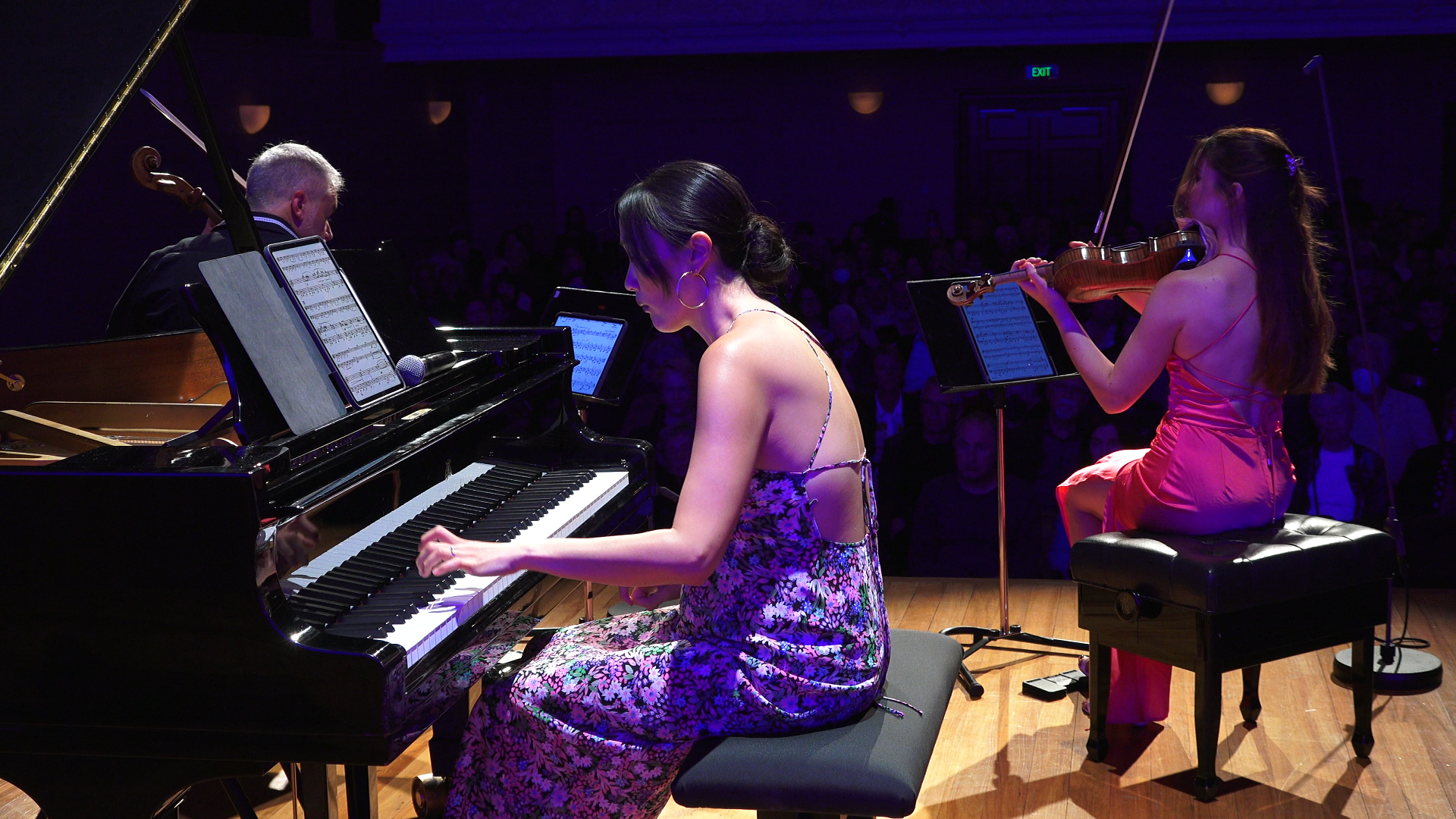Tectonic Uprising
15dec6:00 pmTectonic UprisingSunday Performance at AAG
Event Details
NZTrio’s 2019 Tectonic series is all Empires and Superpowers – the fundamental forces that shape our land, our population, our society. Each concert charts a musical course from Captain Cook’s
Event Details
NZTrio’s 2019 Tectonic series is all Empires and Superpowers – the fundamental forces that shape our land, our population, our society. Each concert charts a musical course from Captain Cook’s homeland in old England, to the sounds of Aotearoa prior to his arrival on these shores. We examine this European genre, piano trio music, as it has developed within Aotearoa’s unique culturally intertwined society, and compare with the result of development within a British environment.
In UPRISING, we hear parlour music from Bridge, and a rediscovered trio by Elgar – mannered distractions from the building of empires and the noise of war and industrialisation in the England of their time. Later the music of Charlotte Bray illuminates contemporary England while also looking back to the enduring words of Shakespeare – and New Zealand composer, Samuel Holloway, turns our gaze inward to the human landscape and the mechanisms of hearing. In the second half, the prescience and experimentation of US composer, Charles Ives meets the subversive rebellion of Shostakovich – two profoundly contrasting sides of an iron curtain that takes on new meaning and significance today.
Sunday December 15th, 6pm in Auckland Art Gallery’s beautiful North Atrium
Programme approx. 90 mins plus interval, followed by complimentary drinks and nibbles with the musicians:
Frank Bridge (UK): Hornpipe
Edward Elgar (UK): Lento assai – Allegro moderato
Samuel Holloway (NZ): Stapes
Frank Bridge (UK): Valse Russe
Charlotte Bray (UK): That Crazed Smile
Charles Ives (US): Trio
Dmitri Shostakovich (USSR): Piano Trio No.2 in e minor
Approx. 90 mins plus interval
Tickets $50 Adult / $40 AAG Members / $25 Students
Time
December 15, 2019 6:00 pm UTC+12:00(GMT+00:00)
Location
Auckland Art Gallery
Programme Notes
TECTONIC UPRISING
Frank Bridge (UK) Hornpipe
Edward Elgar (UK) Lento assai – Allegro moderato
Samuel Holloway (NZ) Stapes
Frank Bridge (UK) Valse Russe
Charlotte Bray (UK) That Crazed Smile
Charles Ives (USA) Trio
Dmitri Shostakovich (RUS) Piano Trio No.2 in e minor
Frank Bridge (UK; 1879 – 1941): 2 Miniatures for Piano Trio, Set 3
ii. Hornpipe
i. Valse Russe
More of Frank Bridge’s irresistible miniatures! His life falls into two periods: the composer of beautiful chamber music, much of it composed for himself to play on the viola (he was the violist of the fabulous Joachim quartet) or for friends of his at the Royal College of Music; and then the staunch pacifist and musical radical, Benjamin Britten’s beloved teacher, who also became a popular conductor at the Proms. What happened in between was the First World War. These lovely miniatures come from the first part, composed the year after he’d won first prize for piano trio in the famous Cobbett competition. Hornpipe opens the concert, and Valse Russe follows Samuel Holloway’s Stapes later in the programme.
Edward Elgar (UK; 1857 – 1934): Lento assai – Allegro moderato
Elgar wrote very little chamber music: massed string tone and the orchestra was more his style. The success of the Enigma variations in 1899 changed everything. This was a composer who was entirely self-taught – his only training came from his piano-tuner father and the rest from library books – who was expert enough at the piano and violin to be teaching when he was still in his teens. He was never able to afford study in Leipzig and yet did all the arranging and accompanying for the entire Worcester Glee Club, and when he was only 22 gave up his reliable full-time job as a solicitor’s clerk to become conductor of the band of the Worcester and County Lunatic Asylum. It was there that he learnt how to play almost every instrument there was. So we have the string quartet: the piano quintet: two pieces for violin, and a duet for trombone; and this! One of several attempts he made to write a piano trio, doomed like the others to incompletion. This one dates to 1920, just after the dismaying premiere of his cello concerto. It was completed by Elgar enthusiast Paul Adrian Rooke for the 150th birthday celebrations in 2007.
Samuel Holloway (NZ; b. 1981): Stapes
Stapes is the first piece in a series of three trios collectively entitled Middle Ear. The stapes (or stirrup) is the smallest in the chain of three bones that transmit vibrations from the eardrum to the internal ear in the process of transformation of external sound waves to a response within the listener. In this work, the players work both together and against each other, in individual and collective struggles for articulacy.
Samuel studied music and philosophy at the University of Auckland, and currently manages the contemporary art and design programmes at Unitec Institute of Technology. He is the Associate Director (Artistic) of the 2020 ISCM World New Music Days, was the 2013 Mozart Fellow at the University of Otago, 2016 Civitella Ranieri Fellow in Umbria, Italy, and finalist in the 2011 SOUNZ Contemporary Award for his work Sillage, a work that was selected for the 2014 ISCM World New Music Days in Poland.
Charlotte Bray (UK; b. 1982): That Crazed Smile
The second of three Shakespeare-inspired piano trios by Charlotte Bray, one of the UK’s most awarded and widely performed young composers. At the age of only 27, just after graduating, she was appointed apprentice Composer-in-Residence with the Birmingham Contemporary Music Group (one of the most famous new music groups in the world) and has made good on the promise, with commissions immediately flowing in from the big London orchestras and some of the best festivals in Europe, from chamber music for Aix-en-Provence and Cheltenham, to opera for Covent Garden and a concert-opener for the BBC Proms. This trio was commissioned by the Oberon Trio to mark the 400th anniversary of Shakespeare’s death, and evokes the fairies and star-crossed lovers of A Midsummer Night’s Dream – as she puts it, a playful dream-world illuminated by occasional flashes of lightning.
~ Interval ~
Charles Ives (USA; 1874 – 1954): Trio
i. Moderato
ii. TSIAJ (“This scherzo is a joke”). Presto
iii. Moderato con moto
“Music is life”
You understand Charles Ives better when you consider his father George. George Ives was the youngest bandmaster in the whole Civil War, with the finest band in the Union: returning to settle in a small town in Connecticut he turned it into the most musical town in the state, and he was clearly a force of nature like his son, innately inquisitive and enquiring, so fascinated by music – any music – that he taught his boys to sing in one key while he played in another. He built instruments to play in quarter-tones, took his cornet out into the middle of a lake to demonstrate the sound over water, and set two bands marching round a park with different tunes for the sheer joy of what would happen when they passed. When young Charles first banged with his fists upon the piano his father’s only remark was to suggest he learn the drums. And so we get the composer known as the great Yankee maverick, decades ahead of his time, whose music is at once incredibly sentimental and nostalgic, rooted in old American band tunes and church music, and in another sense so avant-garde and freewheeling that it can even seem challenging today.
He went his own way in life, too, choosing a career in life insurance purely as a way of funding whatever he wanted to do with his music. It worked rather too well. He made himself a fortune, composing whatever he wanted and supporting whoever he wanted (he funded a number of other American composers secretly), only to find that nobody wanted to listen to it. But other composers venerated him. His influence on American music has been incalculable and when Stravinsky was asked his definition of a musical masterpiece, he chose a piece not by Mozart or JS Bach, but Charles Ives.
This trio is the freewheeling Charles Ives, harking back to his student days at Yale – the best days of his life, when he was known as “Dasher” Ives and earned D+ for everything but music. It’s stuffed full of references to folk songs and glee club tunes, especially the scherzo, which includes everything from the folk tune Long, Long Ago to My Old Kentucky Home, fragments of Dixieland and much more besides. He described it himself: “The first movement recalled a rather short but serious talk by an old professor of Philosophy; the second, the games and antics by the students on a holiday afternoon; the last movement was partly a remembrance of a Sunday service on the campus”. You may recognize the church hymn Rock of Ages, which he played as an organist many times.
Dmitri Shostakovich (RUS; 1906 – 1975): Piano Trio No. 2 in e minor
i. Andante
ii. Allegro con brio
iii. Largo
iv. Allegretto
In February 1944 Shostakovich’s greatest friend, Ivan Sollertinsky, died of a heart attack at the age of only 41. Brilliant musicologist, critic, linguist, and professor and administrator at Leningrad University, he was also artistic director of the Leningrad Philharmonic and was with them in Siberia, where the entire orchestra had been evacuated for safety during WWII. They had known each other since they were students: it was Sollertinsky who had opened the composer’s eyes to the glory of Mahler and had stood by him through thick and thin – from the glorious successes of his 20s through to the devastating fall from favour of his opera Lady Macbeth of Mtsensk, which having been championed as a “major achievement of Socialist construction” was suddenly being officially denounced for formalism. So ever since 1936 Shostakovich had had to fend off terrifying inquisitions: he had watched many of his closest friends and relatives disappear into prisons or exile, never to be heard of again; he kept a suitcase by the door just in case a phone call came to flee. And so when Sollertinsky died, just as the war was drawing to a close and everybody was looking forward to better times, Shostakovich was devastated. He wrote to his widow: “I cannot express in words all of the grief I felt when I received the news of the death of Ivan Ivanovich, my closest friend. I owe all my education to him.”
This trio is dedicated to his memory. It’s an elegy to Sollertinsky, particularly the second movement Largo which was also played for the funeral rites of Shostakovich himself: but it’s also a meditation on war, written as the Nazis were retreating from the eastern front and the horrors of the death camps of Majdanek and Treblinka were being exposed to the world. Shostakovich was particularly horrified by reports that SS guards had made their victims dance beside their own graves, hence the Jewish finale – he uses this tune again in his autobiographical string quartet no 8.
The cello opens in eerily high harmonics, an andante lamentation which leads into an energetic fugue on all three instruments. A sharply rhythmical, violent scherzo follows and then the grief-laden Largo, the emotional heart of the piece. Finally, the Jewish dance, unrolling like a shell-shocked danse macabre before it gives way at the end to memories of the beginning, a brief glimpse of the piano’s passacaglia from the slow movement and the muted anguish of stratospheric strings.
Programme notes by Charlotte Wilson


